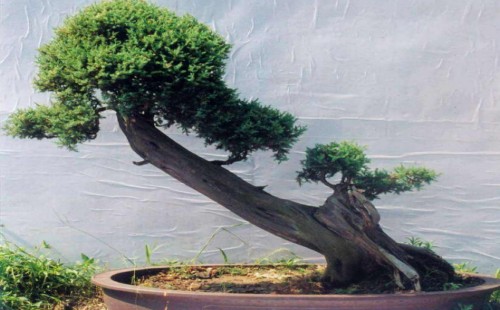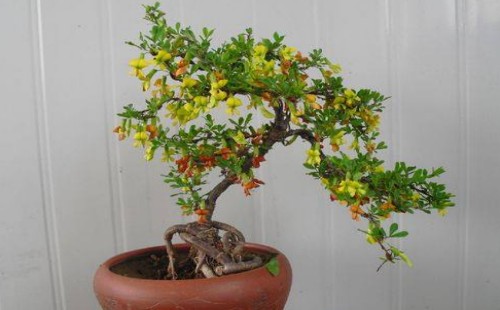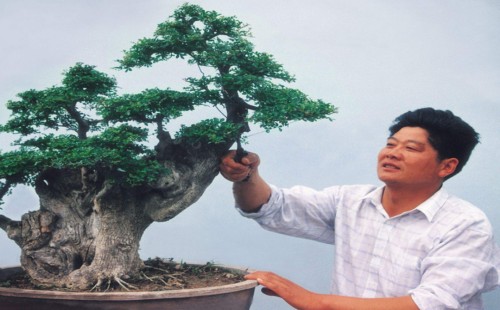The modeling of oblique dry bonsai
There are many shapes of bonsai trees, and the oblique dry style is one of the more common styles. The oblique dry bonsai has a sloping straight pole, the foundation is firm, and the center of gravity is tilted to one side, which looks very steep. Although the straight rod of the oblique dry bonsai is tilted, its rhizome is firmly grasped in the opposite direction, with the potential of "four or two poking a thousand jin", which is a typical feature of the oblique dry bonsai.

Oblique dry bonsai has a unique style, full of charm and artistic charm, but the strange shape is generally not inborn, but completed by people's post-processing. Whether the ornamental and artistic value of oblique dry bonsai is high or not will directly reflect the technical level of the creator. Today, the editor will share with you the shape of the oblique dry bonsai. I hope you will have a more in-depth understanding of this style.
First, straight oblique dry modeling
The most typical feature of the straight oblique stem modeling effect is that the trunk theme part is straight and inclined, while the top part of the trunk can be bent and twisted. On the whole, the lower part of the trunk is quite masculine, while the top highlights the feminine state, while the root of the stump grabs the ground in the opposite direction. On the other hand, the floating branches can balance the center of gravity and strive for stability in danger. Obviously, with the straight oblique dry modeling effect of the tree bonsai, although the trend of the trunk and the top branch develop in the same direction, they form a sharp angle with each other and extend upward, bringing a kind of dynamic but full of charm.
If the floating branch is replaced with a drag branch, it will be integrated with the trunk and the top column, so that the center of gravity of the bonsai will deviate from the root, but the strong grabbing of the ground will stabilize the precipitous situation, just like a ship that breaks down in a storm, despite the wind and waves. but still stand tall. While the dry body of the bonsai tree is tilted, coupled with half floating and half falling branches in the same direction, it has a dangerous cliff artistic conception, which is full of interest.
Second, hard angle curved oblique dry modeling
For this kind of bonsai tree, its dry body is relatively straight, but it is very strong and powerful, and the situation is intimidating. However, for this kind of oblique dry modeling effect, we often need to grow according to the material, strong and soft, and need to be stable in danger, reflecting its personality and characteristics. There are two main forms: one is that the dry body is hard-angled and inclined upward, the dry potential and the top branch are raised at the same time, the top is formed by the sharp branch, the probing branch is released from the high position, and the trend is opposite to the top branch. The other is that the dry body shows multiple hard angles and remains curved and oblique, but the top branch should look at the head and root in the opposite direction, and take the reverse trend-the falling branch in the high position can make up for the empty part of the high foot at the lower end, while taking the lower potential can strengthen the sense of motion to the right, so the shape has a unique style in exaggeration.
Third, soft angle curved oblique dry modeling
This kind of oblique dry bonsai style, its dry body generally has a variety of curvature, and soft and hard angles show the potential of interchange. The original bonsai shows a more fleshy state due to the dry body of bonsai, which is just in line with people's understanding of the beauty of the curve, which is easier for people to accept. But for this kind of modeling effect, the focus is usually on shaping charm, so as to highlight rigidity in softness, which is neither charming nor vulgar.
Moreover, the dry body of the bonsai tree shows the trend of soft bending transition, the head root protrudes strongly, and the transition to the top is also very natural, and the fortitude of the top branch forms a sharp contrast with the lower end, while the floating branch released from the high position takes its right potential to make it more dangerous, but the tug that grasps the ground tightly can well balance the center of gravity of the pile scene. From this point of view, the whole bonsai is chic, handsome and elegant, full of charm, which is a kind of popular modeling effect.
Fourth, the shape of oblique dry trees
The characteristic of this kind of bonsai is that its dry body is inclined to float, although the pile scenery is low, there is no lack of strong and robust state, which can also bring a kind of intimidating momentum and strength. But there are also two forms of this styling for reference:
One is to match the larger floating branches in the same direction with the appropriate place to highlight the strange and dangerous effect of modeling, which is also a more conventional way of modeling; the other is to use the combination of dragging branches and exploring branches to shape. For the second approach, it is mainly equipped with exploratory branches on one side of the sloping dry body to emphasize the sense of motion, while dragging branches are arranged on the other side to stabilize the center of gravity, which looks not only dignified and elegant, but also very individual.
Time: 2019-06-06 Click:
- Prev

How to water the canary bonsai
Canary bonsai is of high ornamental value, which is very suitable for flower appreciation, and the canary has the characteristics of drought tolerance, so the requirement for water is not very high. However, the canary is not resistant to waterlogging, too much watering can easily cause retting and rotting roots, thus affecting the normal growth of the plant. Especially at the beginning of pots and flowering.
- Next

How to trim the white wax bonsai in order to keep the appearance beautiful
Docking white wax bonsai is a work that has been deliberately processed by people. although it has been trimmed for a long time to maintain a perfect modeling effect, it still has not lost its vitality and can often continue to grow. On the contrary, if it is not pruned in time, with the continuous germination and growth of new branches
Related
- Fuxing push coffee new agricultural production and marketing class: lack of small-scale processing plants
- Jujube rice field leisure farm deep ploughing Yilan for five years to create a space for organic food and play
- Nongyu Farm-A trial of organic papaya for brave women with advanced technology
- Four points for attention in the prevention and control of diseases and insect pests of edible fungi
- How to add nutrient solution to Edible Fungi
- Is there any good way to control edible fungus mites?
- Open Inoculation Technology of Edible Fungi
- Is there any clever way to use fertilizer for edible fungus in winter?
- What agents are used to kill the pathogens of edible fungi in the mushroom shed?
- Rapid drying of Edible Fungi

